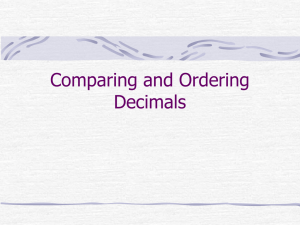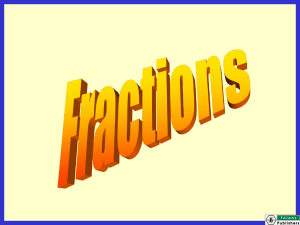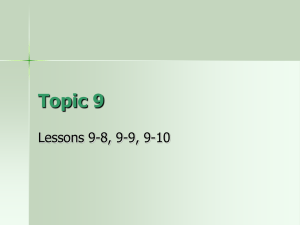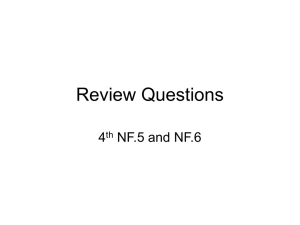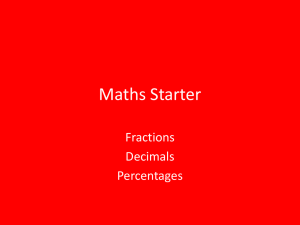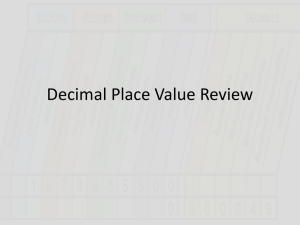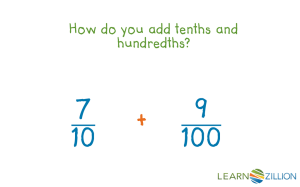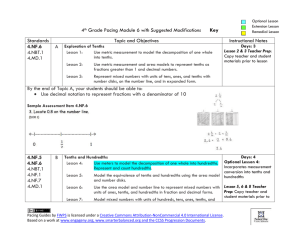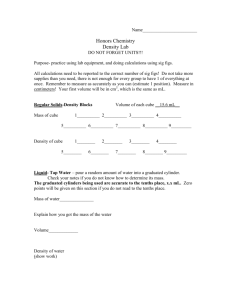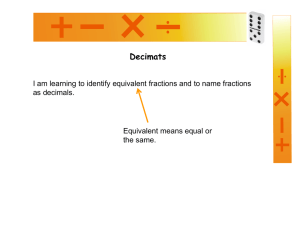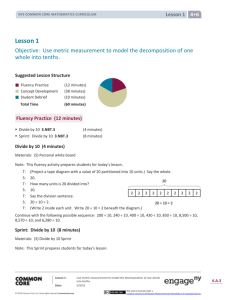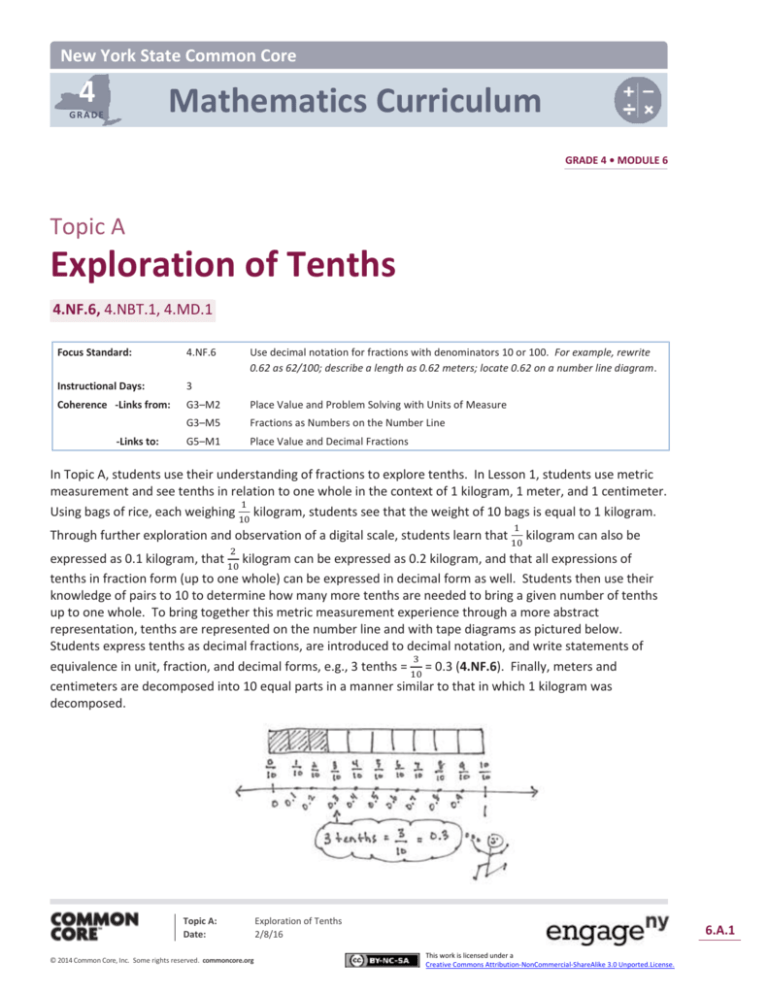
New York State Common Core
4
Mathematics Curriculum
GRADE
GRADE 4 • MODULE 6
Topic A
Exploration of Tenths
4.NF.6, 4.NBT.1, 4.MD.1
Focus Standard:
4.NF.6
Instructional Days:
3
Coherence -Links from:
G3–M2
Place Value and Problem Solving with Units of Measure
G3–M5
Fractions as Numbers on the Number Line
G5–M1
Place Value and Decimal Fractions
-Links to:
Use decimal notation for fractions with denominators 10 or 100. For example, rewrite
0.62 as 62/100; describe a length as 0.62 meters; locate 0.62 on a number line diagram.
In Topic A, students use their understanding of fractions to explore tenths. In Lesson 1, students use metric
measurement and see tenths in relation to one whole in the context of 1 kilogram, 1 meter, and 1 centimeter.
1
Using bags of rice, each weighing 10 kilogram, students see that the weight of 10 bags is equal to 1 kilogram.
Through further exploration and observation of a digital scale, students learn that
2
kilogram, that
10
1
10
kilogram can also be
expressed as 0.1
kilogram can be expressed as 0.2 kilogram, and that all expressions of
tenths in fraction form (up to one whole) can be expressed in decimal form as well. Students then use their
knowledge of pairs to 10 to determine how many more tenths are needed to bring a given number of tenths
up to one whole. To bring together this metric measurement experience through a more abstract
representation, tenths are represented on the number line and with tape diagrams as pictured below.
Students express tenths as decimal fractions, are introduced to decimal notation, and write statements of
3
equivalence in unit, fraction, and decimal forms, e.g., 3 tenths = 10 = 0.3 (4.NF.6). Finally, meters and
centimeters are decomposed into 10 equal parts in a manner similar to that in which 1 kilogram was
decomposed.
Topic A:
Date:
© 2014 Common Core, Inc. Some rights reserved. commoncore.org
Exploration of Tenths
2/8/16
6.A.1
This work is licensed under a
Creative Commons Attribution-NonCommercial-ShareAlike 3.0 Unported.License.
Topic A 4 6
NYS COMMON CORE MATHEMATICS CURRICULUM
In Lesson 2, students return to the use of metric measurement, this time to investigate decimal fractions
4
8
greater than 1. They draw lines using a centimeter ruler that measure, e.g., 2 or 6 centimeters, and
10
10
recognize that those numbers can also be expressed in unit form as 24 tenths centimeters or 68 tenths
centimeters. Students represent decimal numbers using the area model and see that numbers containing
ones and fractions, i.e., mixed numbers, can also be expressed using decimal notation, e.g., 2.4 or 6.8; they
4
4
also write more sophisticated statements of equivalence, e.g., 2 = 2 + and 2.4 = 2 + 0.4 (4.NF.6).
10
2 ones
10
4 tenths
In Lesson 3, students work with place value disks and the number line to represent and identify decimal
numbers with tenths as a unit. To explore the place value of each unit in a decimal number with tenths,
students use number disks to rename groups of 10 tenths as ones. Next, students learn to record the value of
each digit of a mixed number in fraction expanded form, followed by decimal expanded form, e.g., 2 ones 4
4
1
tenths = 2 10 = (2 × 1) + (4 × 10 ) and 2.4 = (2 × 1) + (4 × 0.1). Finally, students model the value of decimal
fractions within a mixed number by plotting decimal numbers on the number line.
A Teaching Sequence Toward Mastery of Exploration of Tenths
Objective 1: Use metric measurement to model the decomposition of one whole into tenths.
(Lesson 1)
Objective 2: Use metric measurement and area models to represent tenths as fractions greater than 1
and decimal numbers.
(Lesson 2)
Objective 3: Represent mixed numbers with units of tens, ones, and tenths with number disks, on the
number line, and in expanded form.
(Lesson 3)
Topic A:
Date:
© 2014 Common Core, Inc. Some rights reserved. commoncore.org
Exploration of Tenths
2/8/16
6.A.2
This work is licensed under a
Creative Commons Attribution-NonCommercial-ShareAlike 3.0 Unported.License.

